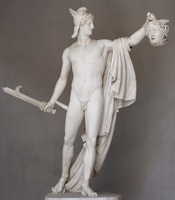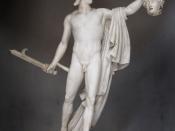Perseus with the Head of Medusa:
This piece, made to replicate the Greek classical style, stands tall above entrance to the Metropolitan Museum of Art. This sculpture, created by Antonio Canova in marble, was done in the early 19th century. Historically, the tale of Perseus and how he killed the beast-woman, Medusa, is from eons before, however, the artist chose to recreate this scene from Greek mythology. In addition, Canova uses many techniques that were used by Greek sculptors, he use of detailed anatomy, a combination of stoicism and portrayals of anguish, stiff posture, contrapposto and the draping of the fabric around Perseus' arms.
Perseus stands rigidly, looking at the head of Medusa. His expression is unchanged. One leg bends toward her head, but it does so in a rigid, uncomfortable manner. He holds his sword out on his right, and her head on his left. Fabric is draped unnaturally off his left arm and it falls to the floor behind him.
He has the ideal body, with perfectly sculpted and toned muscles. Perseus is naked, save a pair of very decorative and ornate sandals. His body is in a curve, with his spine. He appears to be a warrior, and he is triumphant in his defeat of Medusa. A feeling of pride overwhelms one when they look at him, however, it is hard to relate to him, because he does not feel real. He is humanized, but does not appear natural or normal.
Medusa, or rather her head, is held by its hair in Perseus' left hand. He holds it out from him, in disgust. Her face is writhing in pain, as she has been decapitated. Her snake-hair is very representational, and doesn't look like real snakes. Still, however, her face does not illustrate the true anguish...


![English: Antonio Canova — Perseus with the head of Medusa the Gorgon, Metropolitan Museum of Art, NY. Italiano: Antonio Canova — Perseo, Metropolitan Museum of Art, New York, [1804/1806]. Русский: Antonio Canova — Персей с головой Горгоны Медузы, Музей Ме](https://s.writework.com/uploads/1/11127/english-antonio-canova-perseus-head-medusa-gorgon-metropolit-thumb.jpg)